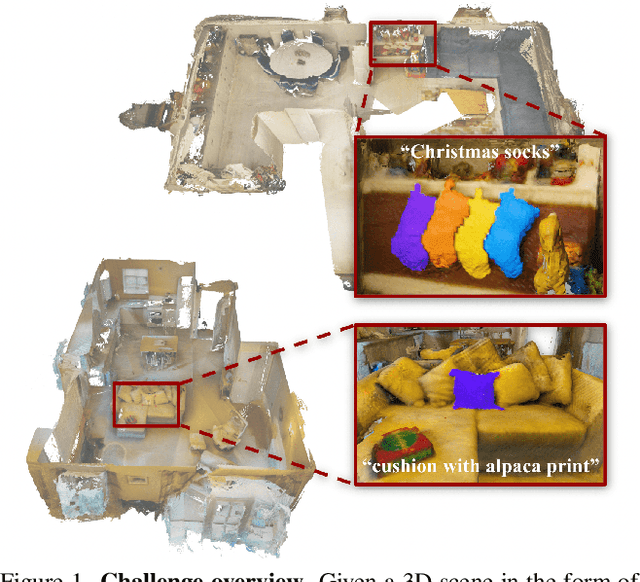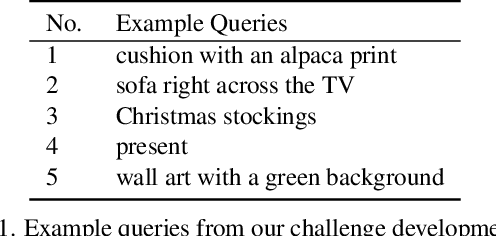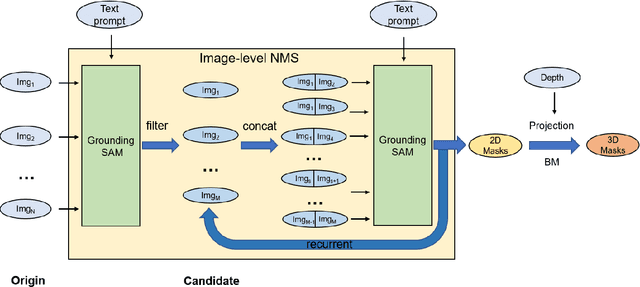Chunjie Wang
UAV-Enabled Fluid Antenna Systems for Multi-Target Wireless Sensing over LAWCNs
Sep 26, 2025Abstract:Fluid antenna system (FAS) is emerging as a key technology for enhancing spatial flexibility and sensing accuracy in future wireless systems. This paper investigates an unmanned aerial vehicle (UAV)-enabled FAS for multi-target wireless sensing in low-altitude wireless consumer networks (LAWCNs) for achieving the low-altitude economy (LAE) missions. We formulate an optimization problem aimed at minimizing the average Cram\'er-Rao bound (CRB) for multiple target estimations. To tackle this non-convex problem, an efficient alternating optimization (AO) algorithm is proposed, which jointly optimizes the UAV trajectory, the antenna position of the transmit fluid antennas (FAs) and the receive FAs, and the transmit beamforming at the UAV. Simulation results demonstrate significant performance improvements in estimation accuracy and sensing reliability compared to conventional schemes, e.g., the fixed position antenna scheme. The proposed system achieves enhanced sensing performance through adaptive trajectory design and beamforming, alongside effective interference suppression via the flexible FAS antenna repositioning, underscoring its practical potential for precision sensing in the UAV-enabled LAWCNs.
RSMA-Enhanced Data Collection in RIS-Assisted Intelligent Consumer Transportation Systems
Sep 11, 2025Abstract:This paper investigates the data collection enhancement problem in a reconfigurable intelligent surface (RIS)-empowered intelligent consumer transportation system (ICTS). We propose a novel framework where a data center (DC) provides energy to pre-configured roadside unit (RSU) pairs during the downlink stage. While in the uplink stage, these RSU pairs utilize a hybrid rate-splitting multiple access (RSMA) and time-division multiple access (TDMA) protocol to transmit the processed data to the DC, while simultaneously performing local data processing using the harvested energy. Our objective is to maximize the minimal processed data volume of the RSU pairs by jointly optimizing the RIS downlink and uplink phase shifts, the transmit power of the DC and RSUs, the RSU computation resource allocation, and the time slot allocation. To address the formulated non-convex problem, we develop an efficient iterative algorithm integrating alternating optimization and sequential rank-one constraint relaxation methods. Extensive simulations demonstrate that the proposed algorithm significantly outperforms baseline schemes under diverse scenarios, validating its effectiveness in enhancing the data processing performance for intelligent transportation applications.
QoS-Aware Integrated Sensing, Communication, and Control with Movable Antenna
Aug 11, 2025Abstract:Integrated sensing, communication, and control (ISCC) has emerged as a key enabler for low-altitude wireless networks with enhanced adaptability through resource allocation co-design and intelligent environment awareness. However, dynamic interference and channel attenuation constrain the potential of the ISCC system. To address this challenge, we propose a novel movable antenna-empowered ISCC system. An achievable data rate maximization problem is formulated while guaranteeing the sensing and control quality-of-service (QoS) by optimizing the positions of the antennas and the beamforming strategy for communication, sensing, and control co-design. An efficient alternating optimization (AO)-based algorithm is proposed to solve the highly coupled non-convex problem. Numerical results demonstrate that the proposed AO-based algorithm achieves substantial gains in the achievable data rate and the control QoS compared with benchmark schemes.
Latency Minimization for Multi-AAV-Enabled ISCC Systems with Movable Antenna
Aug 07, 2025Abstract:This paper investigates an autonomous aerial vehicle (AAV)-enabled integrated sensing, communication, and computation system, with a particular focus on integrating movable antennas (MAs) into the system for enhancing overall system performance. Specifically, multiple MA-enabled AVVs perform sensing tasks and simultaneously transmit the generated computational tasks to the base station for processing. To minimize the maximum latency under the sensing and resource constraints, we formulate an optimization problem that jointly coordinates the position of the MAs, the computation resource allocation, and the transmit beamforming. Due to the non-convexity of the objective function and strong coupling among variables, we propose a two-layer iterative algorithm leveraging particle swarm optimization and convex optimization to address it. The simulation results demonstrate that the proposed scheme achieves significant latency improvements compared to the baseline schemes.
Movable Antennas Meet Low-Altitude Wireless Networks: Fundamentals, Opportunities, and Future Directions
Jun 16, 2025



Abstract:With the rapid development of low-altitude applications, there is an increasing demand for low-altitude wireless networks (LAWNs) to simultaneously achieve high-rate communication, precise sensing, and reliable control in the low-altitude airspace. In this paper, we first present a typical system architecture of LAWNs, which integrates three core functionalities: communication, sensing, and control. Subsequently, we explore the promising prospects of movable antenna (MA)-assisted wireless communications, with emphasis on its potential in flexible beamforming, interference management, and spatial multiplexing gain. Furthermore, we elaborate on the integrated communication, sensing, and control capabilities enabled by MAs in LAWNs, and illustrate their effectiveness through representative examples. A case study demonstrates that MA-enabled LAWNs achieve significant performance improvements over traditional fixed-position antenna-based LAWNs in terms of communication throughput, sensing accuracy, and control stability. Finally, we outline several promising directions for future research, including the MA-assisted unmanned aerial vehicle (UAV) communication/sensing, the MA-assisted reliable control, and the MA-enhanced physical layer security.
Coordinated Beamforming for RIS-Empowered ISAC Systems over Secure Low-Altitude Networks
May 30, 2025Abstract:Emerging as a cornerstone for next-generation wireless networks, integrated sensing and communication (ISAC) systems demand innovative solutions to balance spectral efficiency and sensing accuracy. In this paper, we propose a coordinated beamforming framework for a reconfigurable intelligent surface (RIS)-empowered ISAC system, where the active precoding at the dual-functional base station (DFBS) and the passive beamforming at the RIS are jointly optimized to provide communication services for legitimate unmanned aerial vehicles (UAVs) while sensing the unauthorized UAVs. The sum-rate of all legitimate UAVs are maximized, while satisfying the radar sensing signal-to-noise ratio requirements, the transmit power constraints, and the reflection coefficients of the RIS. To address the inherent non-convexity from coupled variables, we propose a low-complexity algorithm integrating fractional programming with alternating optimization, featuring convergence guarantees. Numerical results demonstrate that the proposed algorithm achieves higher data rate compared to disjoint optimization benchmarks. This underscores RIS's pivotal role in harmonizing communication and target sensing functionalities for low-altitude networks.
The Fourth Monocular Depth Estimation Challenge
Apr 24, 2025Abstract:This paper presents the results of the fourth edition of the Monocular Depth Estimation Challenge (MDEC), which focuses on zero-shot generalization to the SYNS-Patches benchmark, a dataset featuring challenging environments in both natural and indoor settings. In this edition, we revised the evaluation protocol to use least-squares alignment with two degrees of freedom to support disparity and affine-invariant predictions. We also revised the baselines and included popular off-the-shelf methods: Depth Anything v2 and Marigold. The challenge received a total of 24 submissions that outperformed the baselines on the test set; 10 of these included a report describing their approach, with most leading methods relying on affine-invariant predictions. The challenge winners improved the 3D F-Score over the previous edition's best result, raising it from 22.58% to 23.05%.
Movable-Antenna Array Empowered ISAC Systems for Low-Altitude Economy
Jun 11, 2024



Abstract:This paper investigates a movable-antenna (MA) array empowered integrated sensing and communications (ISAC) over low-altitude platform (LAP) system to support low-altitude economy (LAE) applications. In the considered system, an unmanned aerial vehicle (UAV) is dispatched to hover in the air, working as the UAV-enabled LAP (ULAP) to provide information transmission and sensing simultaneously for LAE applications. To improve the throughput capacity, we formulate a data rate maximization problem by jointly optimizing the transmit information and sensing beamforming and the antenna positions of the MA array. Since the data rate maximization problem is non-convex with highly coupled variables, we propose an efficient alternation optimization based algorithm, which iteratively optimizes parts of the variables while fixing others. Numerical results show the superiority of the proposed MA array-based scheme in terms of the achievable data rate and beamforming gain compared with two benchmark schemes.
Joint Association, Beamforming, and Resource Allocation for Multi-IRS Enabled MU-MISO Systems With RSMA
Jun 05, 2024



Abstract:Intelligent reflecting surface (IRS) and rate-splitting multiple access (RSMA) technologies are at the forefront of enhancing spectrum and energy efficiency in the next generation multi-antenna communication systems. This paper explores a RSMA system with multiple IRSs, and proposes two purpose-driven scheduling schemes, i.e., the exhaustive IRS-aided (EIA) and opportunistic IRS-aided (OIA) schemes. The aim is to optimize the system weighted energy efficiency (EE) under the above two schemes, respectively. Specifically, the Dinkelbach, branch and bound, successive convex approximation, and the semidefinite relaxation methods are exploited within the alternating optimization framework to obtain effective solutions to the considered problems. The numerical findings indicate that the EIA scheme exhibits better performance compared to the OIA scheme in diverse scenarios when considering the weighted EE, and the proposed algorithm demonstrates superior performance in comparison to the baseline algorithms.
OpenSUN3D: 1st Workshop Challenge on Open-Vocabulary 3D Scene Understanding
Feb 23, 2024



Abstract:This report provides an overview of the challenge hosted at the OpenSUN3D Workshop on Open-Vocabulary 3D Scene Understanding held in conjunction with ICCV 2023. The goal of this workshop series is to provide a platform for exploration and discussion of open-vocabulary 3D scene understanding tasks, including but not limited to segmentation, detection and mapping. We provide an overview of the challenge hosted at the workshop, present the challenge dataset, the evaluation methodology, and brief descriptions of the winning methods. For additional details, please see https://opensun3d.github.io/index_iccv23.html.
 Add to Chrome
Add to Chrome Add to Firefox
Add to Firefox Add to Edge
Add to Edge